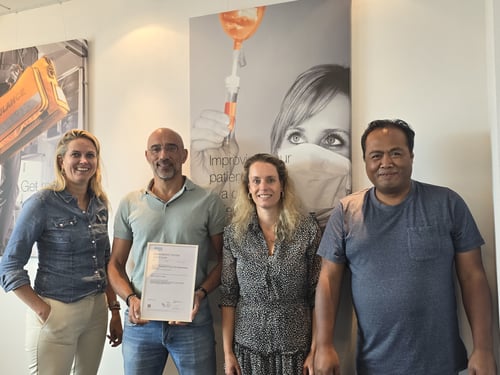Developing healthcare benchmarks is part of a larger risk management strategy aimed at providing organizations with valuable information in a timely manner. Healthcare leaders can then use the benchmark data to keep patients and employees safe. Benchmarked data can come from external or internal sources. Incident data is a critical component of this strategy.
Even though medical errors and workplace accidents are inevitable, what’s less predictable is how organizations handle them:
- Are incidents closely examined, or are they swept under the rug, so to speak?
- What’s the organizational goal for treatment of incident data?
- Does every participant in the healthcare continuum understand their role: a) when an incident occurs and b) what to do to mitigate the risk of future events
Staff must be continually trained on how to help avoid mistakes by using the data available to them. That’s where incident reporting and healthcare benchmarks come into play. The safest healthcare organizations are those that track all incident data and set safety benchmarks against which they hold themselves accountable to ensure ongoing performance improvement.
What are health and safety benchmarking, and why is it important?
Health and safety benchmarking refers to a process by which healthcare organizations monitor their current processes and performance using their own incident data. Organizations can compare this data internally (i.e., across multiple locations within the enterprise), or they can use an external partner such as Joint Commission International (JCI).
JCI promotes five patient safety goals. To accomplish these goals, healthcare organizations must be able to collect and analyze incident data and then use it to set and achieve healthcare benchmarks for patient safety.
Safety benchmarking is important because it helps healthcare organizations reduce accidents and ill-health as well as improve compliance with health and safety law. It can also help organizations improve their reputation in the community as a provider of safe patient care. In the U.S., for example, patients can compare providers based on deaths, complication rates, readmissions, or hospital-acquired conditions (e.g., patient falls, pressure ulcers, or air embolism). They then use this information to make decisions about where to receive their care, gravitating largely toward providers who demonstrate through their data that they provide safe patient care.
Quality benchmarks vs. safety benchmarks
Healthcare quality benchmarks are meant to improve the efficiency, equity, and timeliness of patient care, while healthcare safety benchmarks are meant to eliminate, prevent, reduce, or mitigate injury and harm. For example, healthcare quality benchmarks might focus on patient wait times or the time between symptom onset and hospitalization, while healthcare safety benchmarks might focus on the number of patient falls or medication error rates.
The pros and cons of using internal vs. external benchmarks?
Internal healthcare safety benchmarks can help with consistency and uniformity across the enterprise. The good news is that these benchmarks are often easier and more cost-effective to create and maintain because there’s no reliance on an external data partner. The organization simply “compares itself to itself” over time.
The major disadvantage? When a healthcare organization uses internal benchmarks, it may only have a myopic view into opportunities for performance improvement. That’s because it has no idea whether its own performance is on par with that of other similar organizations.
External healthcare safety benchmarks, on the other hand, can help organizations identify industry best practices to gain a competitive edge. National averages can be helpful, but they don’t necessarily provide a reasonable benchmark for every organization because there is so much variation in terms of patient population, severity, social determinants of health, and other factors.
When using external benchmarks, it’s important to choose a peer or group of peers that provides an accurate comparison. The following characteristics are important:
- Bed size
- Procedure volume
- Provider type
- Case-mix index
- Unit/department
- Geographic type (i.e., urban, rural, or suburban)
- Region
External benchmarks are important in terms of helping hospitals understand how they can better manage resources, reduce costs, improve outcomes across episodes of care, drive real-time interventions, and optimize value-based payment programs. By looking outside of the organization, healthcare leaders can judge their organization’s own performance against that of others and pinpoint specific strategies to improve.
What data should hospitals benchmark internally?
Determining what specific data to benchmark will depend on regulatory compliance, of course, but also each healthcare organization’s unique goals. The key is to make data-informed decisions, meaning that incident data should be used to identify areas of vulnerability and opportunities for process improvement. If organizations don’t prioritize incident reporting, they’ll have no idea where to concentrate their efforts in terms of benchmarks. Having an incident management plan is critical.
What type of incident data should you collect, and how?
Incident data plays a critical role in benchmarking. This includes data from all incidents, including low-, medium-, and high-risk incidents; incidents that are quickly corrected; and near misses. Each of these occurrences has something to teach organizations. Not recording them equates to a missed learning opportunity.
In addition, organizations must be able to measure and track incidents across all care settings, including outpatient, ambulatory, retail clinics, specialty settings, and care given via telemedicine. Technology can help organizations collect and manage that data to identify root causes and ultimately improve quality and patient safety.
For workplace accidents, for example, collect information about any incidents that result in:
- A fatality
- Loss of consciousness
- Needle sticks or puncture wounds
- Intensive medical treatment
- Time off from work
- Restricted job functions or transfers
- Loss of hearing or breathing problems
Tips for benchmarking of healthcare incident data
For more than 15 years, The Patient Safety Company, a symplr company, has successfully guided healthcare organizations in their goals to achieve safety and quality improvements for patients and staff. Based on that experience, we offer the following safety benchmarking tips.
- Start with high-hazard, high-risk areas where most harm could be done. What do your incident reports and data reveal? Where is the greatest potential for patient harm? This is a good place to start in terms of creating benchmarks.
- Use standardized definitions and reporting formats. Standardized forms require everyone to report the same information, making it easier to analyze the incident and spot trends over time. These standardized forms should be easy for people to fill out, ideally with the option to complete them digitally. The more cumbersome the form, the less likely staff and others are to report the incident.
>> Read more about developing standards for hospital-wide patient safety - Involve appropriate team leaders in setting the benchmarks, thresholds, and improvement targets. Supervisors play an important role in creating an open atmosphere in which medical errors are viewed as learning opportunities. Supervisors, team leaders, and quality managers or safety commissions can also be tasked with accessing and acting on real-time information (e.g., the number and type of incidents and the root causes) from a dashboard. Immediate action is critical because it can save lives. These individuals can also take the lead on investigating any incidents and encouraging employees to speak up about workplace hazards, unsafe practices, and actual accidents.
How healthcare organizations use benchmarks for learning and cross-departmental knowledge sharing
The key to continuous improvement is to share incident data and talk about it. Use this data to identify educational opportunities enterprise-wide. Chances are likely that if one department struggles with a patient safety issue, another one might experience that same struggle as well. Create an environment in which errors are embraced—not ignored. Share best practices and ideas with the common goal of high-quality patient care and employee safety in mind.
The Patient Safety Approach
Our unique software platform offers ready-to-use cloud solutions for data collection, workflow management, and process automation. Each solution identifies and analyzes risks, reveals trends, and enables continuous quality improvement. Together, the applications form a complete system for quality and risk management tailored to the needs of your organization. Contact us today for a free demo.

%20(3)%20(1).jpg)
.jpg?length=500&name=170131%20VIM%20platform%20(1).jpg)

